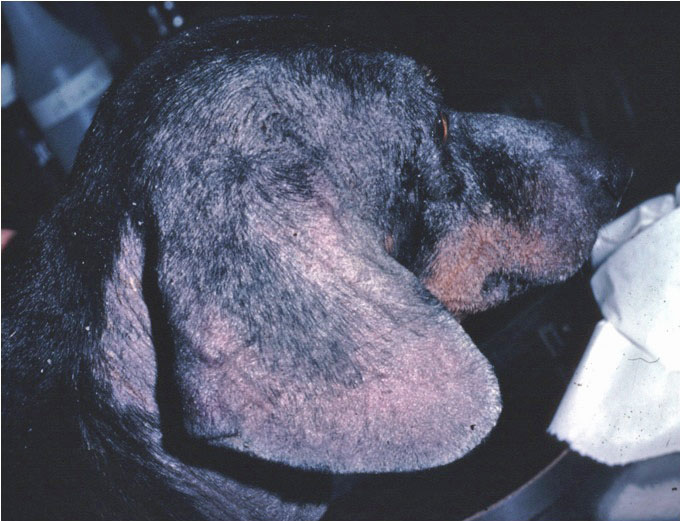Derm Disease: Ear Margin Dermatosis

Ear margin dermatosis is an uncommon skin condition affecting the edges of the ears in dogs. At first glance, it may appear as a vasculitis, another disease that affects the edges of animals’ ears, but the underlying causes are different. Whereas the many possible causes of vasculitis have been identified, ear margin dermatosis is largely idiopathic, meaning the exact cause is not known.
Ear margin dermatosis is described mainly in dachshunds but other breeds may be affected most of which also have long hanging ears: Dobermans, Dalmatians, Springer Spaniels, Cocker Spaniels, Beagles and Bassett Hounds. There have been reported cases in dogs with erect ears and dogs with ear crops as well.
Patients with this condition usually have a gray to yellow crust and greasy material and follicular casting along the margins and tips of the ears. Scraping can generally readily remove the material and matted hairs; in others it is firmly attached. The skin in these areas is dry and scaly, although in more severe cases painful fissures that bleed easily may be present. This can lead to head shaking which causes further damage to the cracked skin on the ear margins. Most pets do not display evidence of pruritus or itchiness. Lesions usually appear on the tips of the ears, but can affect the entire border of the earflap.
The early diagnosis of ear margin dermatosis is based upon the breed, history and presence of the
characteristic ear margin lesions. Scabies
should be ruled out through skin scraping or trial acaracidal therapy. Other differentials including primary keratinization defects, hormonal issues, and vasculitis may require additional diagnostic procedures to differentiate.
Ear margin dermatosis is a noncurable condition, but in early stages of the disease it can be controlled with topical treatments. Antiseborrheic/keratolytic agents will remove the scale, with treatments varying from daily to weekly. In very severe cases, weeks of daily treatment may be required before improvement is seen. The additional of moisturizers and emollients and the application of barrier function products may be helpful
The advanced stages of the disease with chronic splitting and damaged tissue may be resistant to medical therapy, and may require laser or surgical removal of the affected ear margin.
New Resident Joins Group

Animal Dermatology Clinic is pleased to announce a new resident joining the ADC family.
Dr. Kacie Stetina (pictured here with her dog, Syrus) will be spending her residency and receiving cases at our San Diego, CA clinic. She completed her bachelor's degree in biochemistry at Arizona State University and graduated from Tufts Cummings School of Veterinary Medicine in 2011. She then completed a one-year small animal rotating internship at the VCA West Los Angeles. Upon finishing her internship, she accepted a residency position with the Animal Dermatology Clinic's San Diego location in July 2012.
Dr. Stetina’s interest in dermatology began in 2006, when her own personal dog required a veterinary dermatologist.
Animal Dermatology Clinic was the first private veterinary dermatology practice to offer a residency program and continues to train and mentor veterinarians in this rigorous and demanding program.
Outside of the clinic Dr. Stetina enjoys outdoor activities, traveling, trying both local and ethnic cuisines, playing volleyball and basketball, and spending time training and exercising her American Bulldog.
September Date Set for Satellite in Fort Wayne, IN
Animal Dermatology Clinic – Indiana will begin a new satellite location in Fort Wayne beginning Tuesday, September 25. Dr. Darin Dell will be receiving cases at Aboite Animal Clinic, 4142 Covington Rd.
The initial schedule for Fort Wayne will be one day per month, but increase in the coming months. This latest satellite location brings the total to 21 in 5 states, in addition to our seven full-time locations in four states.
“We hope that this new satellite will offer a convenience to pet owners in the Fort Wayne area. It will save them from driving over two hours to our Indianapolis location,” says Don Fruta, Marketing Manager for Animal Dermatology Clinic.
Dr. Dell is a Fort Wayne resident and is equally pleased to be of service to pet owners in his city.
To make an appointment to see Dr. Dell in Fort Wayne, please call the Indianapolis clinic at 317-578-7773.

 Ear margin dermatosis is an uncommon skin condition affecting the edges of the ears in dogs. At first glance, it may appear as a vasculitis, another disease that affects the edges of animals’ ears, but the underlying causes are different. Whereas the many possible causes of vasculitis have been identified, ear margin dermatosis is largely idiopathic, meaning the exact cause is not known.
Ear margin dermatosis is an uncommon skin condition affecting the edges of the ears in dogs. At first glance, it may appear as a vasculitis, another disease that affects the edges of animals’ ears, but the underlying causes are different. Whereas the many possible causes of vasculitis have been identified, ear margin dermatosis is largely idiopathic, meaning the exact cause is not known.